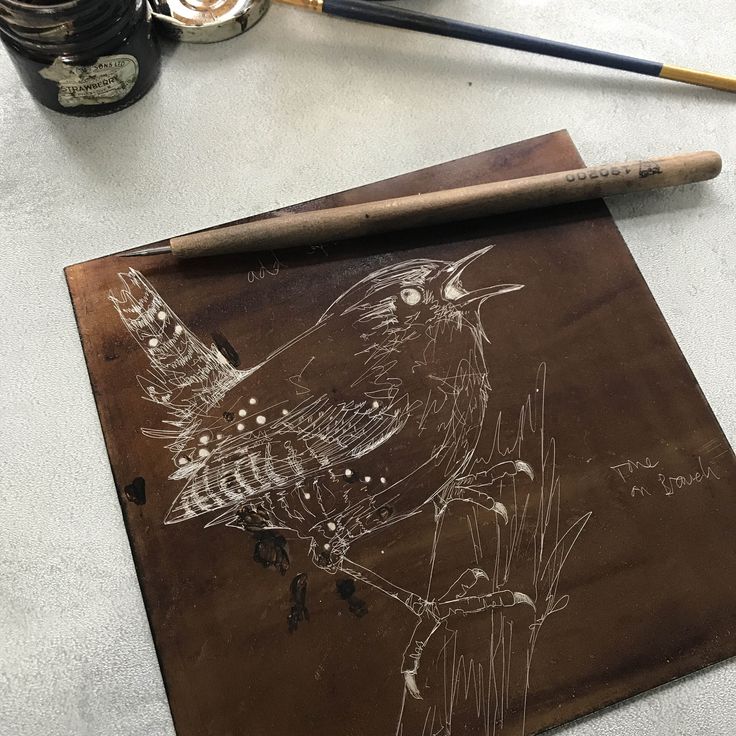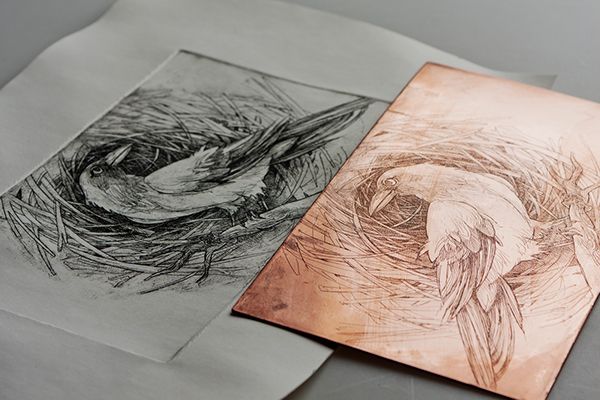The etching is an intaglio printing technique that is a captivating and time-honoured intaglio process that has intricate and versatile methods. This Printmaking process allows artists to create finely detailed, expressive, and richly textured images on a variety of surfaces, most commonly on metal plates through a combination of artistic skills and chemical reactions. Etching stands as one of the four major intaglio techniques in printmaking, alongside engraving, dry point, and aquatint.

History of Etching Printmaking
Its origins are in the intaglio printmaking process, where incised etched lines hold the ink, creating the image on paper. The technique is said to have originated in the 15th century, and also known as metal printmaking, likely in Germany, as artists sought new ways to reproduce intricate drawings and detailed imagery. Initially, metalworkers used a corrosive substance to create designs on armour and weaponry, inspiring artists to experiment with the process of etching printmaking.
Evolution of Etching Art
Over time, artists developed and refined the etching process, The 16th and 17th centuries witnessed a golden age of printmaking, with etching at the forefront of this artistic renaissance. Renowned artists like Rembrandt van Rijn embraced it as a means of self-expression, creating masterpieces that showcased the medium’s ability to convey emotion, depth, and intricate details. Rembrandt’s etchings, such as “The Three Crosses” and “The Hundred Guilder Print,” exemplify the power and subtlety achievable through this technique.
Contemporary Revival
While technological advancements have introduced new methods of image reproduction, etching has not lost its allure. Many contemporary artists continue to explore and experiment with etching, combining traditional techniques with modern approaches. The medium’s unique ability to create rich textures, intricate lines, and atmospheric effects ensures its enduring relevance in the contemporary art scene.
From its humble beginnings as a practical method for metalworkers to its evolution into a refined and expressive art form, etching has left an indelible mark on the world of visual arts. As artists continue to push the boundaries of this versatile technique, etching remains a vibrant and dynamic medium that connects the past with the present, contributing to the ever-evolving landscape of artistic expression.
How to Etch Step-by-Step?
Etching Printing Process
The printing process involves creating images on a metal plate, typically on copper or zinc, through the use of acid.
Here’s a brief step-by-step overview of the etching process.
Plate Preparation
To start the printing process, a metal plate usually copper or zinc is cleaned and polished to create a smooth surface. Secondly, the plate is often coated with an acid-resistant ground; such as Asphaltum or Wax, which will protect the areas that should remain un-etched.
Drawing or Incising
Various tools are used to create the image on the plate by drawing directly onto the ground. The artist incises lines and textures into the plate according to their desire
Stopping Out Varnish
To control the depth of the etch, we can selectively block areas we want to preserve by applying an acid-resistant stop-out varnish for etching. This can achieve various tones and effects.
Etching
Afterwards, you then immerse the incised plate in an acid bath, as a matter of fact, it’s a weak solution of nitric acid. The acid “bites” into the exposed areas of the metal, etched, creating grooves. The longer the plate remains in the acid, the deeper the etched lines and textures will be to achieve the desired effect.
Inking
After achieving the desired level of incising, we clean the plate and apply ink to the surface of the etched plate. The ink sticks to the groves of etched lines and areas.
Wiping the Ink
Wipe the surface of the plate to remove excess ink, leaving ink only in the etched lines and textures. Typically, artists use a net cloth or tarlatan fabric to wipe the plate.
Printing
Place the etched-inked plate on a printing press along with dampened paper. The printing press machine applies great pressure against the plate, transferring the ink from the plate to the paper.
Repeating the Process
You can repeat the etching printmaking process multiple times, with variations in inking and wiping, to create multiple editions of prints. Therefore, each print will have slight variations making each print unique and different from the rest as well.

The printmaking process is a versatile intaglio printmaking technique that allows for intricate etched details and a wide range of tonal values. Valued is its ability to create fine lines, rich textures, and unique, expressive effects. It’s a process that combines artistic skill with chemistry and can yield striking and detailed printed artwork.